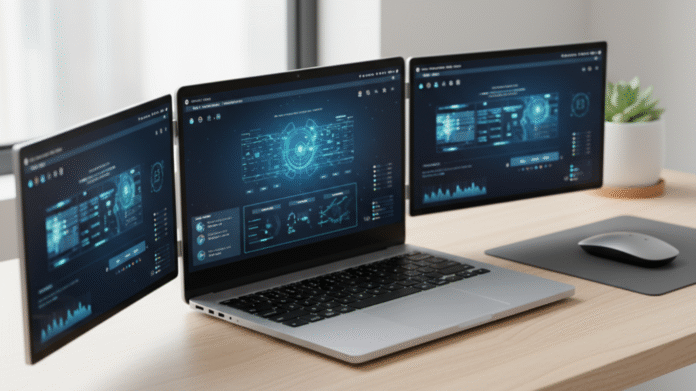A laptop screen extender transforms a standard notebook into a multi-display powerhouse, boosting productivity, creativity, and efficiency whether you’re a remote worker, digital nomad, gamer, or content creator. By seamlessly adding extra screen real estate without the bulk of a desktop setup, these ingenious devices address the ever-growing demand for flexible, portable workstations. This comprehensive guide delves into the benefits, types, setup process, use cases, and buying considerations for laptop screen extenders, ensuring you select the perfect solution to elevate your workflow.
Why You Need a Laptop Screen Extender
Modern workflows often demand juggling multiple documents, applications, and communication tools simultaneously. A single laptop screen can quickly feel cramped when comparing spreadsheets side by side, conducting video calls while referencing presentations, or monitoring real-time analytics alongside coding environments. A laptop screen extender delivers:
-
Enhanced multitasking: Split tasks across multiple displays to reduce window-switching and context-switching.
-
Improved ergonomics: Position screens to reduce neck strain and maintain better posture.
-
Portable flexibility: Attach and detach effortlessly, whether you’re at a café, co-working space, or corporate office.
-
Boosted creativity: Graphic designers and video editors benefit from dedicated timelines, tool palettes, and reference images on separate screens.
By adding even one extra display, you can increase productivity by up to 30%, reduce errors, and maintain a cleaner digital workspace—no desktop required.
Types of Laptop Screen Extenders
1. Slide-Out Dual Monitors
Slide-out extenders integrate directly into the laptop chassis. When closed, they slide under the main display; when needed, they slide out to flank the primary screen.
-
Pros: Seamless integration, no extra cables; powered by laptop battery.
-
Cons: Limited to dual displays; slight increase in thickness and weight.
2. Clip-On Portable Monitors
These are standalone monitors that clip onto either side of the laptop. Many models offer adjustable hinges and 180-degree rotation.
-
Pros: Versatile positioning; some support touch input; can function independently on a desk.
-
Cons: Requires carrying an additional device; power via USB or built-in battery.
3. USB-C/HDMI External Monitors
Traditional portable monitors connecting via USB-C or HDMI offer larger screen sizes, up to 17 inches. They sit beside your laptop on a stand or lay flat.
-
Pros: Larger displays; crisp resolution options (Full HD, 4K); straightforward plug-and-play.
-
Cons: Less integrated; needs a separate power source or USB-C power delivery.
4. Wireless Screen Extenders
Using Wi-Fi Direct or proprietary wireless display protocols, these adapters mirror or extend your desktop to a compatible monitor or TV without cables.
-
Pros: Cable-free setup; ideal for presentations or casual browsing.
-
Cons: Potential latency; depends on network stability; limited resolution.
Setting Up Your Laptop Screen Extender
Hardware Requirements
-
Compatible port: USB-C with DisplayPort Alternate Mode, HDMI, or proprietary connector.
-
Sufficient power: USB-C Power Delivery (PD) support for USB-powered monitors.
-
Sturdy clip or stand: Ensure the extender securely attaches without damaging your laptop.
Software Configuration
-
Connect the Extender
Plug the USB-C/HDMI cable or slide out clip-on screens into the appropriate port. -
Detect Displays
On Windows: Settings > System > Display > Detect.
On macOS: Apple menu > System Settings > Displays > Add Display. -
Arrange Displays
Drag and position the virtual screens to match their physical alignment, ensuring smooth cursor movement. -
Adjust Resolution and Scaling
Match resolution to your extender’s native specs. Apply scaling (e.g., 125–150%) for readability. -
Optimize Color and Brightness
Calibrate color profiles if extending to a high-fidelity monitor; adjust brightness to match the primary screen.
Common Use Cases
Remote Work and Collaboration
Video conferencing on the main screen while referencing project management boards or document drafts on the extended display accelerates team communication and decision-making.
Content Creation
Photo editors can view libraries on one screen and edit tools on another, while video editors place timelines on the primary and preview windows on the extender for real-time feedback.
Stock Trading and Data Analysis
Traders monitor live price feeds, news tickers, and analytical dashboards simultaneously—critical for split-second decisions in volatile markets.
Coding and Development
Developers keep code editors on one display and live previews, terminal windows, or documentation on another—streamlining testing and debugging workflows.
Gaming and Streaming
Streamers can play on the main screen and manage chat, streaming software, and performance stats on the extender without interrupting gameplay.
Benefits and Productivity Gains
-
Reduced Context Switching: Placing reference materials side by side cuts the time wasted toggling between windows.
-
Enhanced Focus: Dedicated spaces for communication, research, and primary work keep distractions minimal.
-
Customizable Layouts: Save display configurations for specific tasks—writing, design, coding—and switch instantly.
-
Portability: Most extenders weigh under 1.5 pounds and pack slim, making them easy to toss into a laptop bag.
Studies indicate that users with dual displays complete tasks up to 40% faster and report lower levels of frustration and mental fatigue—key factors in prolonged remote work environments.
Key Considerations Before Buying
Compatibility
-
Confirm your laptop’s USB-C port supports video output (DisplayPort Alt Mode).
-
Check driver requirements for Windows or macOS.
Display Quality
-
Native resolution: Aim for Full HD (1920×1080) or higher.
-
Brightness: Minimum 250 nits for office lighting; 300+ nits for outdoor use.
Portability vs. Screen Size Trade-Off
-
Larger screens boost visibility but add bulk.
-
If mobility is paramount, choose 12–14-inch clip-on models.
Power and Connectivity
-
USB-C PD: Enables a single cable for video and power.
-
Built-in battery: Offers cable-free operation for a few hours.
Ergonomics and Adjustability
-
Hinged clips or adjustable stands alleviate neck strain.
-
Some extenders support portrait orientation—ideal for long documents or code.
Price Range
-
Entry-level: $80–$150 for basic clip-on Full HD extenders.
-
Mid-range: $150–$250 for larger screens with premium build and touch support.
-
High-end: $250+ for 4K resolution, HDR, and advanced features like pen input.
Tips for Maximizing Your Extended Workspace
-
Color Profile Synchronization
Use built-in calibration tools or third-party utilities to match color temperature across screens for consistent visuals. -
Window Management Software
Employ tools like Microsoft PowerToys FancyZones or Magnet for macOS to snap windows into preset layouts instantly. -
Keyboard Shortcuts
Learn system shortcuts (e.g., Windows+Arrow keys or macOS Mission Control) to move applications swiftly between displays. -
Cable Management
Utilize cable clips and Velcro ties to keep your desk tidy when using wired extenders. -
Regular Breaks and Screen Positioning
Position the top of all screens at eye level and take short breaks to reduce eye strain.
Conclusion
A Laptop Screen Extender revolutionizes how professionals interact with digital content, offering a portable, flexible, and efficient multi-display setup. Whether you’re enhancing collaboration, accelerating creative workflows, or simply craving more digital workspace, extenders cater to diverse needs and budgets. By understanding the types available, setting up correctly, and optimizing your workspace, you can harness the full potential of extra screens—transforming any environment into a high-performance command center. Empower your productivity and embrace the freedom of expanded displays today.

